Do you ever feel buried in submissions, chasing down data, and losing valuable time on paperwork?
Many insurance brokers face the same struggle. Every day, inboxes fill with new submissions, manual processes eat up hours, and deadlines slip because of repetitive tasks.
It’s easy to feel like the work never ends, especially when clients are waiting for quick answers and carriers demand accuracy.
That’s why having the right underwriting tools can make such a difference. Think of them as practical helpers that take on the busywork so you can focus on clients and deals.
Let's talk about 7 underwriting tools that can help you save time, reduce stress, and keep your business moving forward.
What Are Underwriting Tools?
Insurance underwriting is the process of checking risks before offering coverage. It helps companies decide if they should accept a client, how much coverage to give, and what premium to charge.
Traditional underwriting meant going through files by hand. It worked, but it was slow and often left room for errors.
Underwriting tools make the process smoother. These automated systems enable underwriters to use structured data and apply business rules when reviewing risks.
Intelligent document processing (IDP) is often part of these tools, turning messy submissions like scanned forms or bank statements into clean, usable data.
7 Insurance Underwriting Tools to Speed Up Approval Processes
Fast approvals can make or break a deal. Yet many insurance brokers lose valuable time to paperwork, back-and-forth emails, and slow reviews. Here are 7 insurance underwriting tools that can speed up your team's approval process.
1. Heron
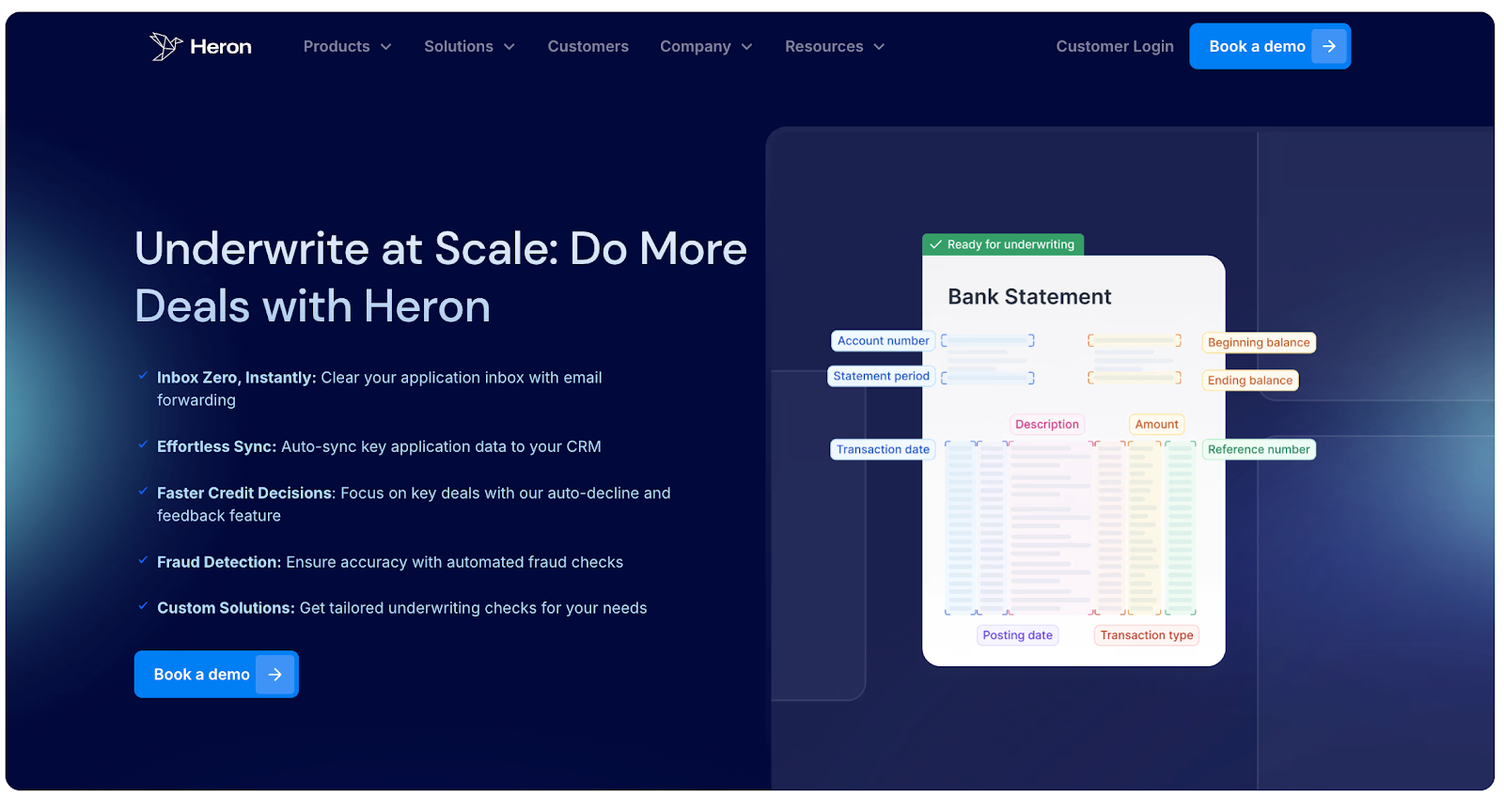
Heron helps insurance brokers speed up underwriting by cutting out the manual work that slows down deal flow.
Instead of spending hours sorting emails, renaming files, or retyping data, Heron scrubs submissions automatically and turns them into structured, decision-ready data in minutes.
The platform reads ACORDs, loss runs, SOVs, and supplemental applications with AI accuracy. Then, it validates every file against your underwriting rules and flags missing or incorrect information.
Brokers can connect Heron directly to their CRM, PAS, or rating engine, so each submission is synced and audit-ready without extra effort.
Key Features
- Automated submission scrubbing – Pulls documents from email, standardizes file names, and categorizes submissions automatically
- Built-in validation – Checks each submission for required documents and coverage details before it reaches underwriters
- Data enrichment – Fills in missing fields with details from trusted sources for a complete application view
- Seamless workflow integration – Connects with your CRM or PAS to auto-create and update records
- Full audit trail – Keeps underwriting transparent and compliant with every submission tracked end-to-end
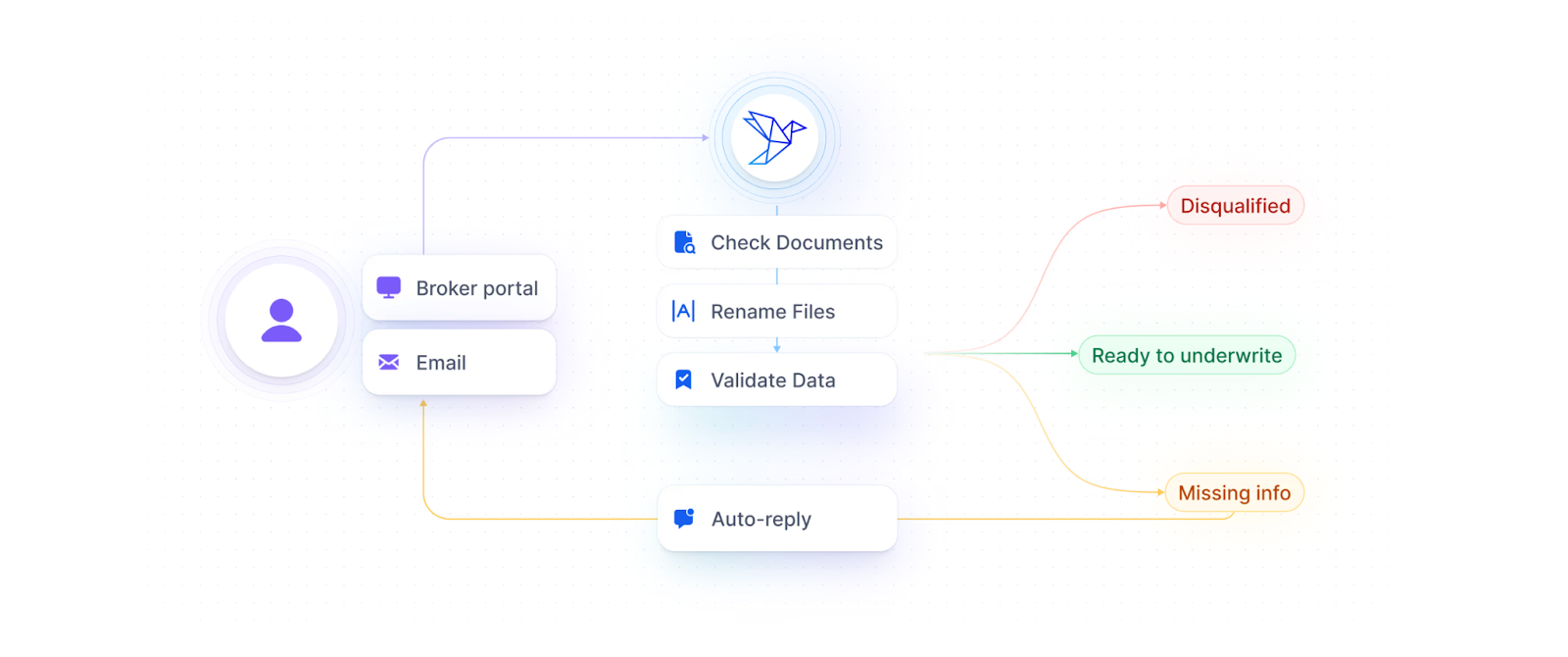
Schedule your demo today and see how easy it is to grow without increasing cost or headcount!
2. FlowForma

FlowForma is an AI-powered process automation platform built to help insurers automate complex workflows across claims, underwriting, and policy management.
As an automated underwriting system, it allows insurance teams to digitize approval processes, reduce manual errors, and improve decision-making without writing code.
Its no-code setup and integration with existing systems make it easier for insurers to speed up claims handling, manage renewals, and maintain full compliance.
Key Features
- No-code automation - Allows users to build and modify workflows for claims, underwriting, and policy administration without coding
- AI-powered Copilot - Uses artificial intelligence to help create and customize approval and underwriting processes quickly
- Seamless system integration - Connects with existing core insurance systems and external data sources for smooth data exchange
- Built-in compliance and audit trails - Embeds traceable actions and controls in workflows to simplify regulatory compliance
- Advanced reporting and analytics - Provides detailed insights into processes, risks, and performance for better decision-making
3. Origami Risk
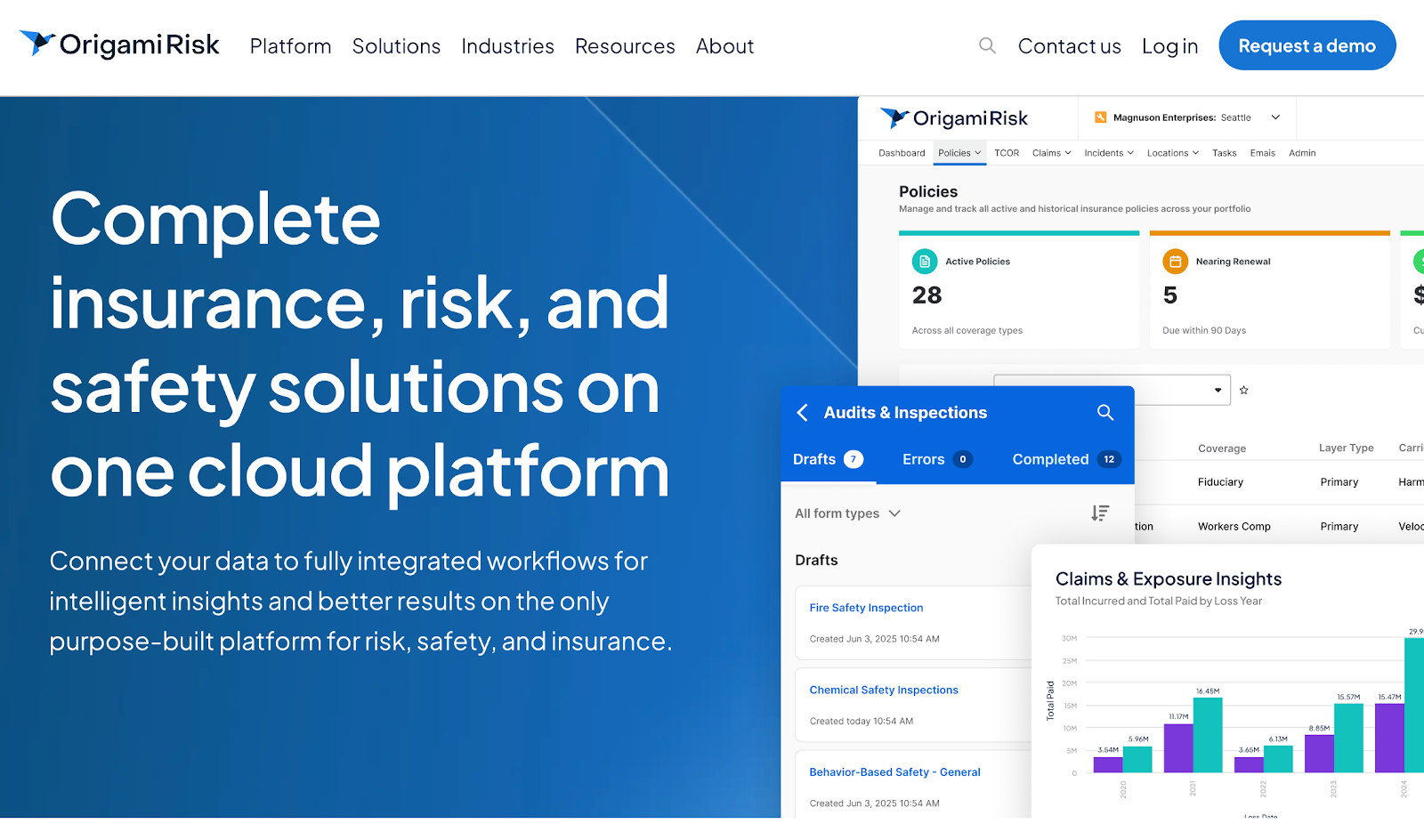
Origami Risk is a cloud platform that combines insurance, safety, and risk management in one system.
It lets brokers and organizations connect data across workflows, making it easier to assess risks and make decisions. The platform also supports policy and claims management while offering tools for safety, compliance, and governance.
With flexible solutions, AI-powered automation, and mobile access, Origami Risk helps users track exposures, check performance, and adjust risk practices as needs change.
Key features
- Risk assessment tools – Evaluate exposures with analytics, dashboards, and reporting features that provide detailed insights
- Risk management capabilities – Manage insurance, safety, and compliance programs within a single platform
- AI-powered automation – Apply AI-driven tools to streamline workflows and improve data analysis
- Configurable solutions – Adjust the system to support specific insurance and risk processes without custom coding
- Mobile data collection – Capture audits, incidents, and field reports directly from the mobile application
4. BriteCore
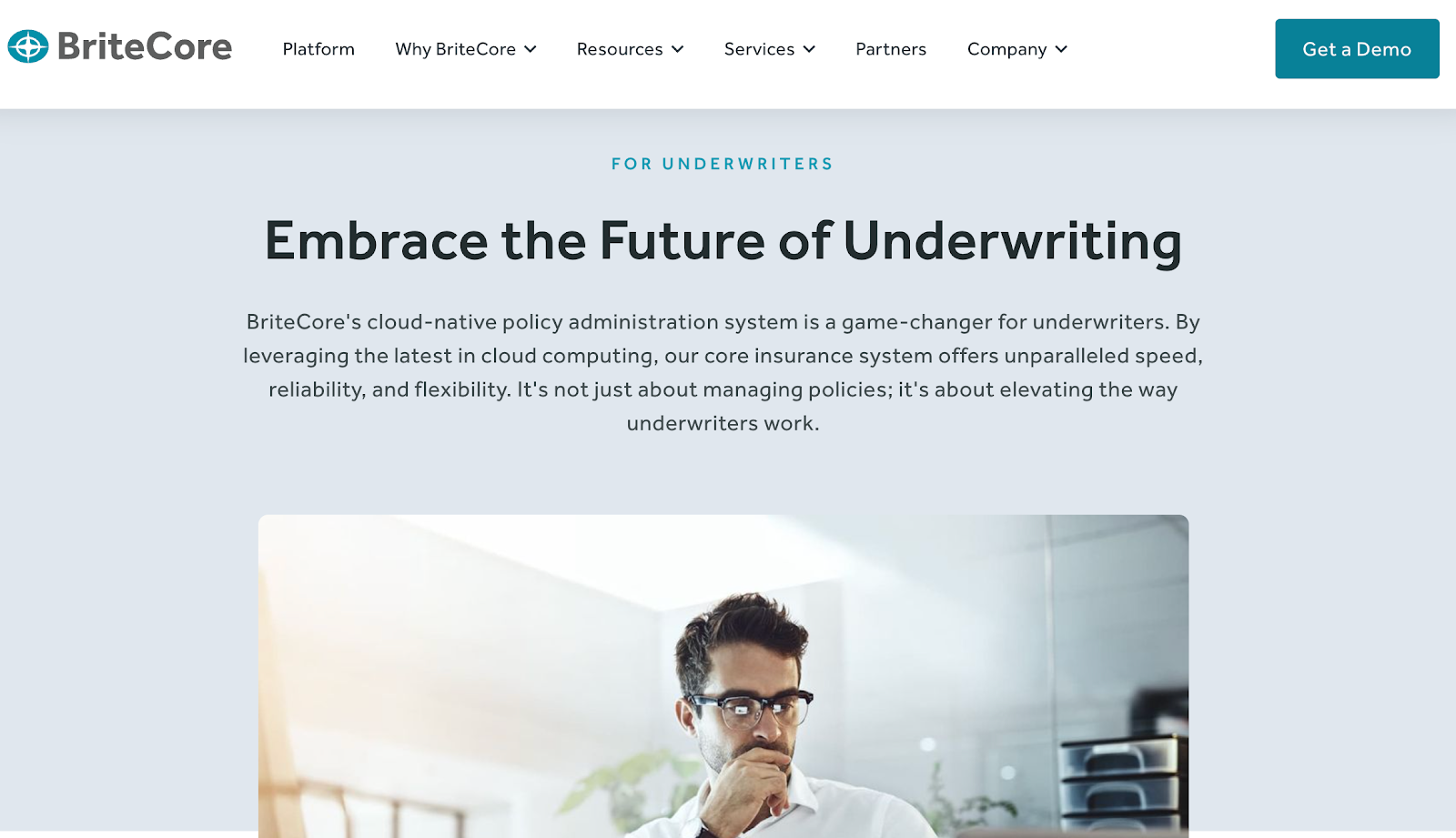
BriteCore is a cloud-native policy administration system built to modernize underwriting for insurance carriers.
Designed for speed, reliability, and scalability, it combines cloud computing with advanced analytics and automation to simplify quoting, policy management, and risk assessment.
BriteCore allows underwriters to work more efficiently, make data-driven decisions, and collaborate in real time across teams and clients.
Key features
- AI-powered risk assessment - Uses analytics and third-party data integrations to help underwriters evaluate risks with higher accuracy
- Automated workflows - Handles routine underwriting tasks automatically, allowing professionals to focus on complex decisions
- Real-time collaboration - Supports instant communication between underwriters, agents, and clients through secure digital tools
- Data-driven decision-making - Provides access to real-time data, predictive analytics, and reporting tools for informed underwriting
- Cloud scalability and flexibility - Offers a cloud-native system that adapts to market changes and supports customization for unique underwriting needs
5. Pega
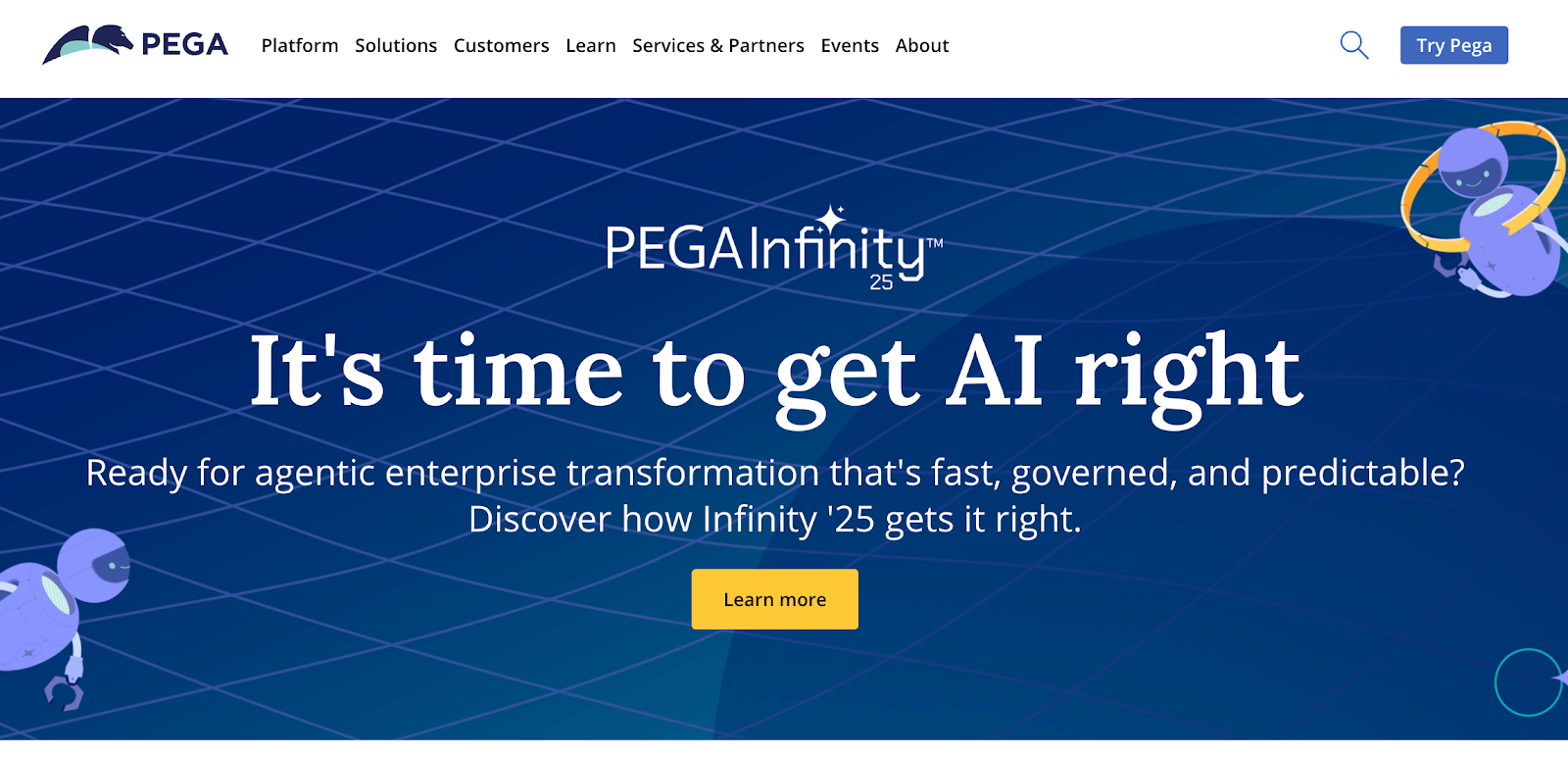
Pega’s underwriting app helps insurance carriers improve the quality of their underwriting, cut costs, and reach new market opportunities. It uses AI-driven decisions to match underwriting outcomes with both profit goals and risk limits.
Analytics are embedded directly into the underwriting process to evaluate risk exposure, guide risk selection, and deliver consistent outcomes.
Intelligent case management and automation increase underwriter productivity while maintaining security, compliance, and auditability.
Key Features
- AI-driven underwriting – Use predictive and adaptive analytics to support risk selection and underwriting outcomes
- Risk exposure insights – Assess risk exposure with integrated data and analytics for more accurate decisions
- Automated underwriting tasks – Automate repetitive underwriting activities based on business rules and guidelines
- Case management – Improve collaboration and productivity while keeping underwriting workflows secure and auditable
- Enterprise integration – Connect with existing systems to eliminate redundancy and extend underwriting functionality
6. Appian
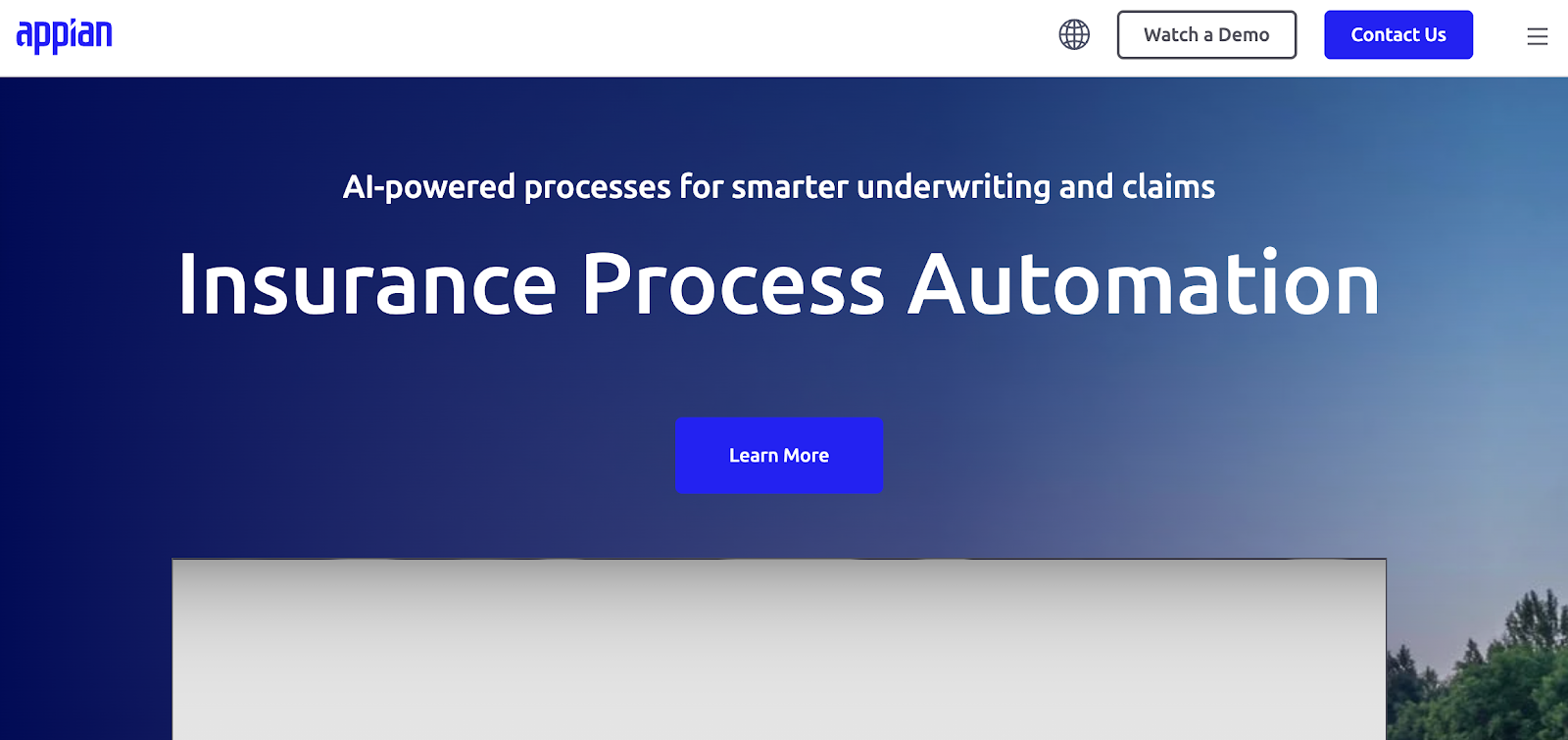
Appian offers an insurance automation platform that brings data together, updates old systems, and allows insurers to manage underwriting and claims more smoothly.
It helps insurers improve customer service, handle claims quickly, and manage new submissions with ease.
The platform includes ready-to-use apps for property and casualty, life and annuities, reinsurance, and specialty insurance. This makes it easy to use across different parts of the business while keeping compliance and control.
Key Features
- Unified systems integration – Connect legacy and modern systems through a single data fabric for greater efficiency
- AI-powered underwriting – Accelerate underwriting processes and improve submission clearance with automated workflows
- Claims automation – Reduce handling time and improve customer experience with faster claims processing
- Self-service portals – Support agents and policyholders with digital portals for easier access to services
- Governance and compliance – Increase data visibility and control to strengthen risk management and regulatory compliance
7. DecisionRules
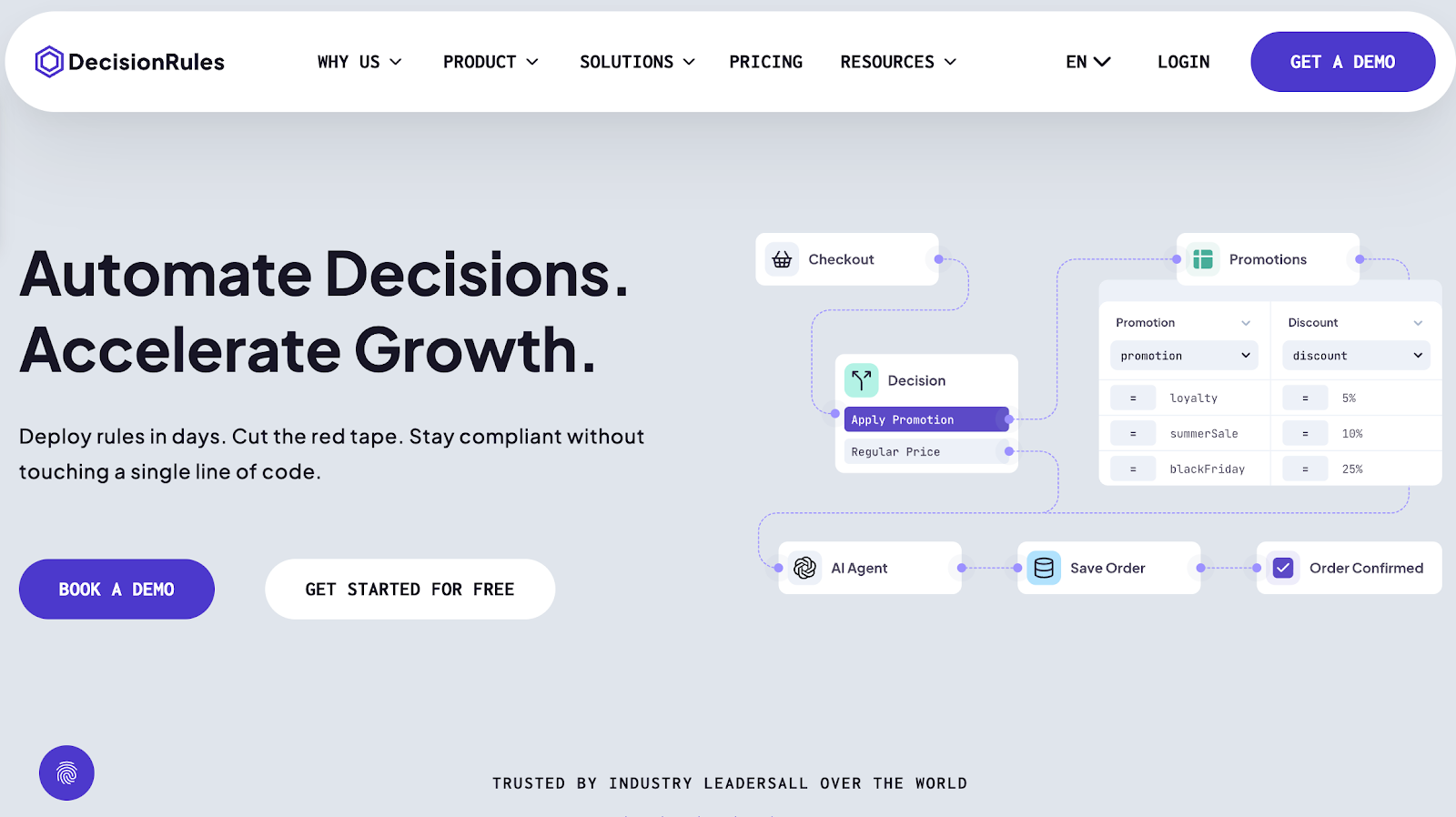
DecisionRules is a business rules platform that helps companies automate decisions in finance, insurance, e-commerce, and logistics.
The platform lets business teams build, test, and launch rules without coding. It also connects with common development tools.
While not technically a software built for insurance, it can be used for underwriting, claims processing, credit approvals, compliance, and fraud detection.
Key Features
- No-code rule design – Create, modify, and deploy business rules using a visual interface without coding
- Automated decision flows – Build end-to-end workflows that automate underwriting, claims, and compliance tasks
- AI assistant – Use AI support to help design and optimize decision rules
- Scalable infrastructure – Handle high volumes of daily decisions with global availability and low latency
- System integrations – Connect with multiple programming languages and platforms through APIs for interoperability
Benefits of Insurance Underwriting Tools
Insurance underwriting tools bring real advantages to insurers and brokers. Let's look at some of them below:
Make Work Faster and Easier
Underwriting automation speeds up the process by taking care of routine tasks.
Systems can handle data collection from many sources at once, giving underwriters complete information without hours of paperwork.
This makes it possible for underwriting teams to prioritize tasks that require their expertise, such as reviewing high-value policies or unusual risks.
Improve Accuracy in Decisions
Modern tools improve the quality of decisions by combining historical data with new data. They generate a clear risk score that underwriters can use as a reliable guide.
For example, if past claims show a pattern in property damage for certain areas, the system will highlight it during the review.
Better Risk Analysis
Large datasets can reveal valuable insights when analyzed properly. Underwriting tools scan information that traditional reviews might overlook.
Connecting weather history with property claims helps insurers identify future risks in specific regions. With this level of detail, insurers are better equipped to minimize losses and set accurate premiums.
Stay Consistent and Compliant
One challenge with traditional underwriting is that decisions can vary from person to person. Automation fixes that by applying business rules the same way for every case. On top of that, access control protects sensitive data, and audit trails log every action.
For example, if a regulator wants proof of how a decision was made, the full record is already in place. This reduces compliance risks and gives insurers confidence that every policy review follows proper guidelines.
Detect Fraud More Quickly
Fraud is a growing concern in insurance. Underwriting tools can analyze patterns in applications and financial statements, compare them against historical data, and flag unusual behavior.
For example, repeated claims from the same property or conflicting information between documents can raise alerts.
Save on Operational Costs
When repetitive work is automated and errors are reduced, operational costs go down. Fewer delays mean fewer resources wasted on rework or corrections.
An automated system that instantly checks documents for missing information saves underwriters from chasing details later.
Create a Better Experience for Clients
Clients notice when underwriting is faster and smoother. They get policies issued quicker, with fair pricing backed by accurate data.
For brokers, this means fewer frustrated clients waiting for approvals and more positive interactions.
Underwriters also gain time to answer questions and build stronger relationships, which leads to better trust and long-term loyalty.
From Inbox to Underwriting in Seconds: Close More Deals with Heron
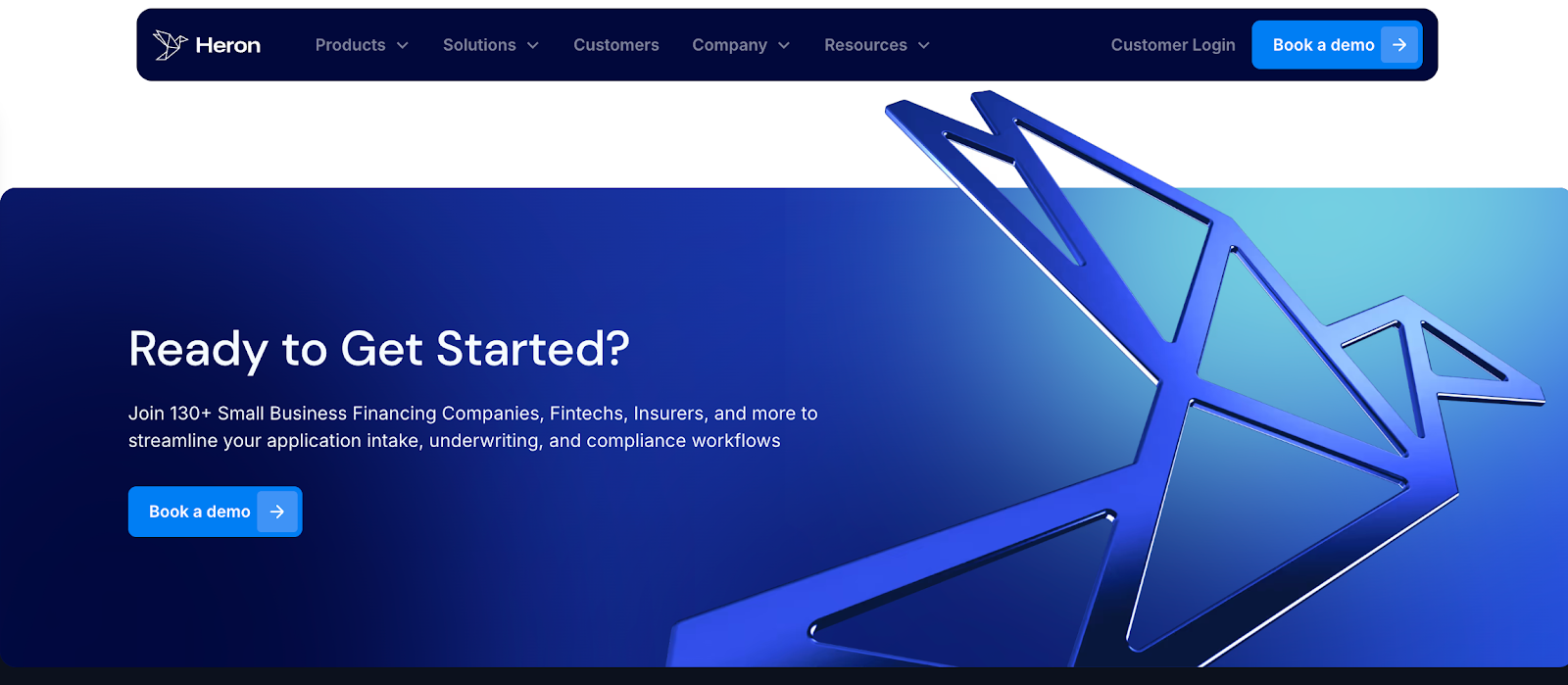
Heron is built for insurance brokers who want to process submissions faster and cut down on manual processes that slow deals.
By plugging directly into your existing workflows, Heron helps streamline workflows without the need for costly rebuilds.
The platform automates the submission process, intake, and policy checks so your team gains a comprehensive view of each deal in real time.
With Heron, human underwriters can focus on making accurate decisions instead of spending hours sorting emails or rekeying data.
Heron also brings the same speed and accuracy to funding. The platform uses AI in lending workflows to cut out manual processes like application intake, bank statement reviews, and decision emails.
Whether you’re processing thousands of submissions each month or competing to quote within hours, Heron helps you stay competitive and responsive.
FAQs About Underwriting Tools
What are underwriting tools?
Underwriting tools are software systems and low-code tools that help insurance and finance teams assess risk, review applications, and make faster decisions. One example tool is Heron, which streamlines underwriting workflows by automating data entry and syncing with CRMs.
What are the three types of underwriting?
The three types of underwriting are loan underwriting, insurance underwriting, and securities underwriting. Each one focuses on evaluating risk and determining terms, whether it’s for a mortgage, an insurance policy, or an investment offering.
What software do mortgage underwriters use?
Mortgage underwriters use platforms that support credit analysis, document review, and compliance checks. Some automated solutions also help handle sensitive data while staying compliant with both internal and external stakeholders.
Many providers now offer cloud native solutions that integrate with third-party vendors, making it easier to process applications, validate information, and triage submissions efficiently.
What are the three main elements of underwriting?
The three main elements of underwriting are risk assessment, pricing, and policy terms. These steps help underwriters decide whether to approve an application, set the right cost, and add any conditions or limits.
